“To know that we know what we know, and that we do not know what we do not know, that is true knowledge.” – Confucius. This ancient wisdom captures the essence of the I Ching, a 3,000-year-old Chinese text that remains a powerful compass for navigating life’s uncertainties.
Rooted in the interplay of yin yang energies, the system uses 64 symbolic hexagrams – each composed of six lines – to reflect universal patterns of change. These combinations serve as mirrors for interpreting personal challenges, relationships, and pivotal decisions.
Historically, practitioners used yarrow stalks or three coins to generate hexagrams through chance. This method blends intention with cosmic alignment, offering insights that bridge logic and intuition. Today, its principles help modern seekers cultivate clarity amid complexity.
More than a divination tool, the I Ching invites deep self-inquiry. By engaging with its symbols, one learns to recognize recurring cycles and make choices aligned with natural harmony. Its timeless framework empowers individuals to transform uncertainty into purposeful action.
Key Takeaways
- The I Ching is a 3,000-year-old Chinese wisdom text focused on interpreting life’s patterns.
- Hexagrams consist of six stacked lines representing yin (broken) and yang (solid) energies.
- Three coins or yarrow stalks are traditionally used to generate guidance through chance.
- Balanced yin yang dynamics underpin all interpretations of change and decision-making.
- Modern applications focus on personal growth, self-awareness, and intentional living.
Introduction to the I Ching and Its Legacy
Emerging from Bronze Age China, the I Ching (Book of Changes) began as oracle bone inscriptions over 3,000 years ago. Rooted in Taoist philosophy, this ancient text reveals universal balance through either broken or solid lines – symbols representing life’s fluid dynamics. Early Chinese rulers consulted it for military strategy and ethical governance.
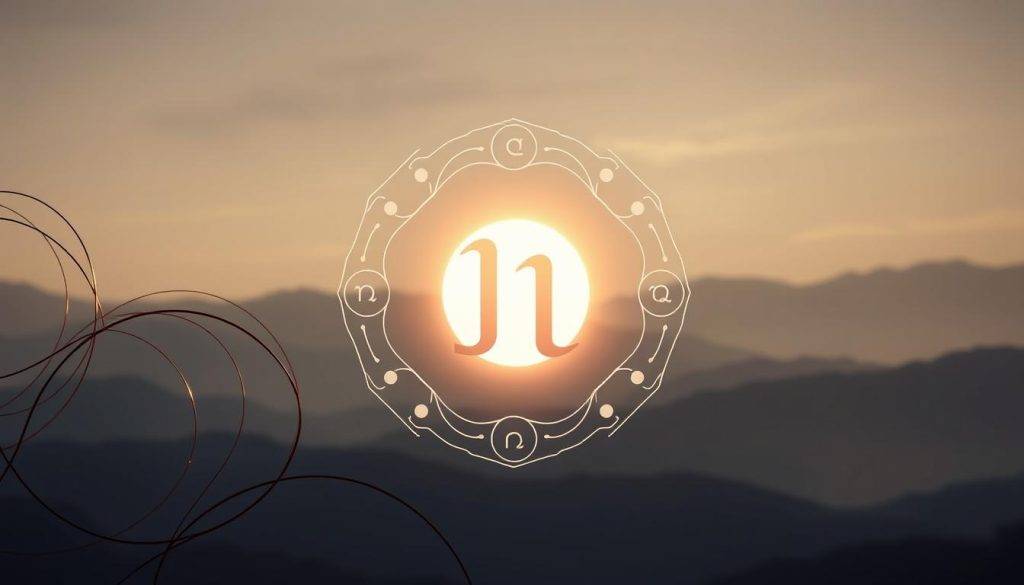
Each hexagram consists of six stacked lines – either broken (yin) or unbroken (yang). These 64 combinations form a modular language for interpreting challenges like career shifts or relationship conflicts. Hexagram 18 (“Work on What Has Been Spoiled”), for instance, guides problem-solving through gradual repair.
The Book of Changes transcended its origins, influencing Confucian thought and Western psychology. Carl Jung incorporated its concepts into his theory of synchronicity. Modern leaders apply its frameworks for strategic decisions, proving its adaptability across eras.
Today, the I Ching remains a bridge between mystical insight and actionable advice. By decoding its hexagrams, anyone can tap into an enduring legacy that turns abstract wisdom into real-world clarity.
Understanding the Basics of the I Ching
The I Ching transforms life’s uncertainties into structured wisdom through its unique symbolic language. Each hexagram—a stack of six lines—serves as a dynamic map for interpreting personal and universal patterns. These configurations, built from either broken or solid lines, reflect Taoist principles of perpetual change and interconnectedness.
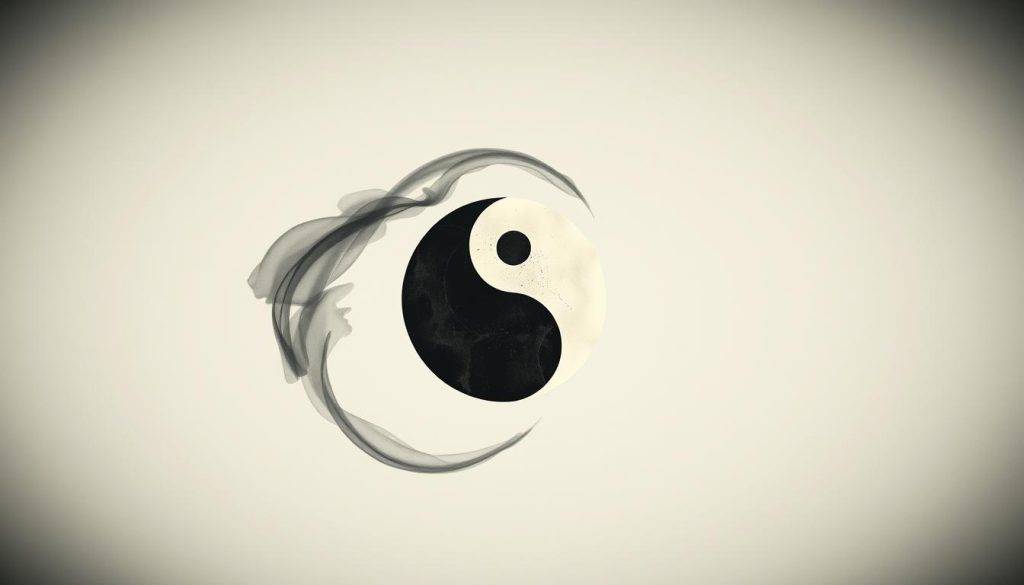
The Ancient Roots and Taoist Philosophy
Taoist teachings emphasize harmony between opposites—a concept embedded in every hexagram. The broken yin line symbolizes receptivity and intuition, while the solid yang line represents action and clarity. Together, they create 64 combinations mirroring natural cycles like seasons or relationships.
This duality extends beyond symbols. The Tao Te Ching states: “The Tao gives birth to one, one gives birth to two…”—a foundation for understanding how yin and yang interact within hexagrams. Practitioners learn to see challenges not as obstacles, but as phases in a larger rhythm.
Structure of Hexagrams and Line Meanings
Each of the six lines holds distinct significance. The bottom line represents a situation’s foundation, while the top reflects its culmination. Middle lines often indicate evolving dynamics—like a career shift or personal transformation.
For example, a broken line in the second position might suggest patience, whereas a solid one could signal decisive action. By analyzing these layers, users uncover guidance tailored to their current life circumstances. This structure turns abstract philosophy into practical steps for growth.
I Ching for Self-Reflection: A Path to Clarity and Insight
Ancient seekers turned to the hexagrams not for answers, but for questions that unlock deeper understanding. This practice transforms uncertainty into a dialogue with one’s inner wisdom, revealing patterns often hidden by daily distractions.

Defining Self-Reflection in the Context of I Ching
Consulting the hexagrams begins with stillness. The ritual of tossing coins—three bronze discs representing heaven, earth, and humanity—creates a pause for intentional inquiry. Each cast line becomes a reflection of current energies, urging users to examine their role within life’s shifting dynamics.
Unlike rigid predictions, these symbols highlight possible paths. Hexagram 36 (“Darkening of the Light”), for example, might suggest retreat during conflict. Such guidance fosters balance between action and acceptance, aligning choices with natural rhythms.
Enhancing Decision-Making Through Inner Wisdom
The hexagrams act as catalysts for clarity. A reading might reveal overlooked perspectives—like how stubbornness stalls progress or fear clouds judgment. By engaging with these insights, individuals learn to trust their innate wisdom while respecting external forces.
Regular practice turns reflection into a habit. Over time, users notice recurring themes in their casts—a signpost for growth areas. This ongoing dialogue nurtures resilience, helping decisions emerge from balance rather than urgency.
Decoding Yin and Yang in the I Ching
At the heart of Taoist philosophy lies yin yang – opposing forces that shape reality through constant interaction. These energies govern everything from seasonal cycles to emotional states, creating equilibrium through complementary contrasts. Understanding this duality unlocks deeper guidance within the Book of Changes.

The Role of Yin and Yang in Life’s Balance
Yin (receptive, dark, feminine) and yang (active, bright, masculine) aren’t fixed states but fluid processes. The I Ching maps their interplay through hexagrams, showing how personal choices align with universal rhythms. Hexagram 11 (“Peace”), for instance, depicts yang ascending – a reminder to act decisively during growth phases.
| Aspect | Yin | Yang |
|---|---|---|
| Energy Type | Passive, reflective | Dynamic, assertive |
| Optimal Time | Night, winter | Day, summer |
| Decision Approach | Wait and observe | Initiate and lead |
Embodying Natural Rhythms and Energy Flow
Aligning with yin yang requires attuning to time and context. Morning routines might emphasize yang energy for productivity, while evenings call for yin-inspired reflection. Regular practice helps recognize when to push forward or pause – like adjusting career plans during economic shifts.
Key applications include:
- Journaling during moon phases (yin) to track emotional patterns
- Scheduling critical meetings during yang-peak hours (9 AM–12 PM)
- Using hexagram readings to identify energy imbalances
Forming Clear Questions for Meaningful I Ching Readings
Crafting precise questions acts as a compass for navigating the method’s wisdom. Open-ended inquiries invite deeper reflection, allowing the energy of the reading to reveal layered insights. This approach aligns with ancient practices where intentional phrasing directed cosmic guidance.

How to Frame Your Inquiry Effectively
Effective questions focus on personal agency rather than fixed outcomes. Instead of asking “Will I get the promotion?”, try “How can I align my actions with career growth?”. This shift engages the method’s transformative potential by emphasizing choice over prediction.
Follow this four-step guide:
- State your situation neutrally (“Navigating a strained partnership”)
- Identify your core intention (“Seeking mutual understanding”)
- Phrase the question to explore possibilities (“What perspectives can improve this relationship?”)
- Eliminate bias by avoiding leading language
| Aspect | Effective | Ineffective |
|---|---|---|
| Focus | Present challenges | Future predictions |
| Phrasing | Open-ended | Yes/No format |
| Outcome | Actionable insights | Passive answers |
Clarity in questioning channels the energy needed for accurate interpretations. Vague inquiries yield ambiguous hexagrams, while focused ones activate the method’s full diagnostic power. Regular practice sharpens this skill, turning doubt into directed curiosity.
Remember: The guide within the Book of Changes responds to deliberate engagement. Well-structured questions become bridges between confusion and clarity, making every reading a step toward self-mastery.
Step-by-Step Guide to Creating Your Hexagram
Mastering hexagram creation bridges intention with cosmic patterns. This ritual transforms abstract thoughts into tangible symbols, revealing hidden layers of your current situation. Whether using coins or stalks, each method fosters reflection while anchoring spiritual concepts to practical steps.

Using the Three-Coin Method
This modern approach balances speed with symbolic depth. Assign values to each coin:
| Coin Side | Value | Line Type |
|---|---|---|
| 3 Heads | 9 (Changing Yang) | ⚊ → ⚋ |
| 2 Heads, 1 Tail | 8 (Static Yin) | ⚋ |
| 1 Head, 2 Tails | 7 (Static Yang) | ⚊ |
| 3 Tails | 6 (Changing Yin) | ⚋ → ⚊ |
- Focus on a specific question tied to your decisions.
- Toss coins six times, starting from the bottom line.
- Record lines based on coin combinations.
- Identify changing lines (6 or 9) to generate a second hexagram.
Overview of the Yarrow Stalk Method
Ancient scholars used 50 yarrow stalks to slow the process, deepening insight. Divide stalks repeatedly to calculate lines through mathematical probabilities. This meditative practice:
- Encourages patience during complex life phases
- Aligns physical movements with mental focus
- Highlights subtle energy shifts in relationships
Both methods map external actions to internal states. The coins offer quick clarity, while stalks cultivate deliberate awareness – two paths to the same insight.
Interpreting the Hexagrams and Changing Lines
Hexagram interpretation unfolds like a conversation with time itself—each line a timestamp revealing layers of meaning. The process begins at the bottom line, symbolizing a situation’s roots, and ascends to its potential outcome. This upward movement mirrors natural growth patterns, from seed to fruition.
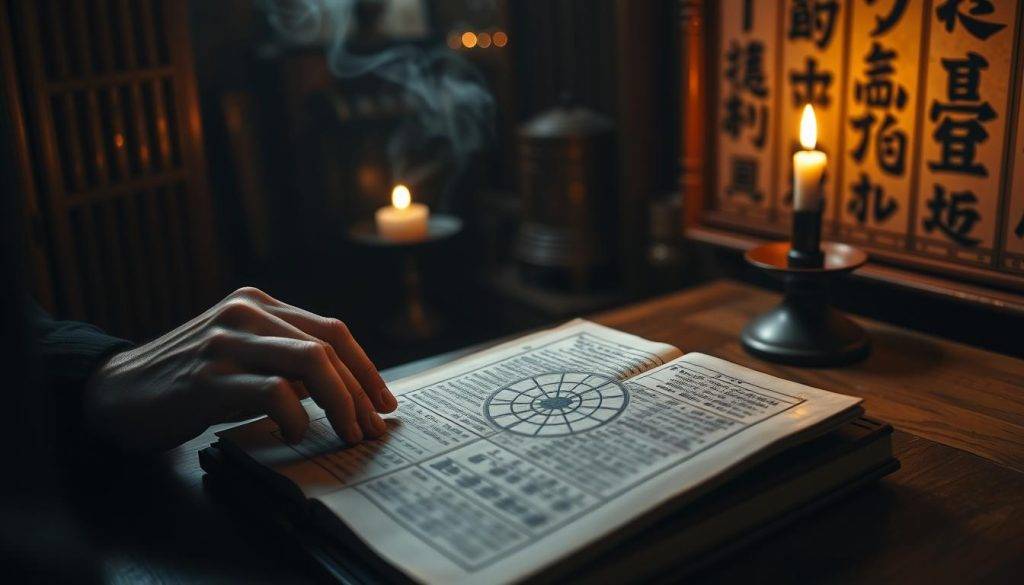
Understanding Each of the Six Line Positions
Every position in the six-line structure reflects distinct phases of development:
| Line Position | Focus | Guidance |
|---|---|---|
| 1 (Bottom) | Foundation | Assess core motivations |
| 2 | Internal growth | Adjust private strategies |
| 3 | Transition | Navigate risks mindfully |
| 4 | External shifts | Align actions with others |
| 5 | Leadership | Exercise informed authority |
| 6 (Top) | Legacy | Evaluate long-term impact |
Changing lines—those marked by 6 or 9 during casting—act as pivot points. They reveal where energy transforms, creating a secondary hexagram. For example, a shifting third line might suggest altering communication tactics in tense relationships.
To refine interpretation skills:
- Compare primary and secondary hexagrams for evolving themes
- Journal recurring symbols across multiple readings
- Contextualize advice within current challenges
This layered approach turns static symbols into dynamic roadmaps. With practice, the meaning within each line becomes clearer—like learning to read weather patterns in shifting winds.
Documenting Your I Ching Reading for Continued Growth
Tracking progress transforms abstract insights into tangible growth markers. A dedicated journal becomes a mirror reflecting patterns within your personal world – revealing connections between readings and life events. Over weeks or months, recurring symbols emerge like seasonal cycles, offering clues to unresolved challenges.
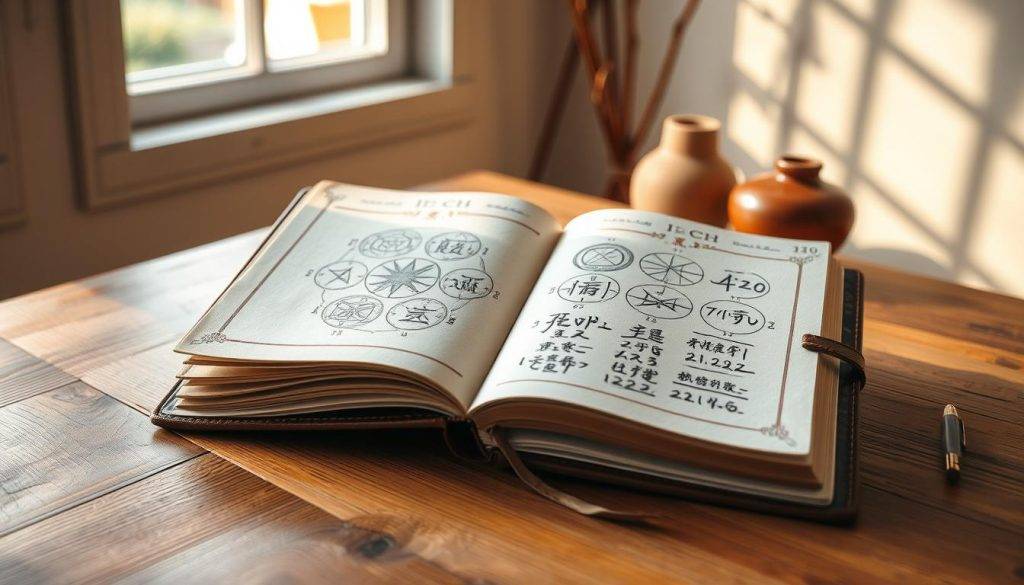
Practical documentation starts with structured entries. Record these core elements for every session:
- Date and emotional state before casting
- Method used (yarrow stalks or coins)
- Primary/secondary hexagrams with changing lines
- Immediate reactions versus later reflections
Noting yarrow stalk counts or coin toss sequences adds depth. These details help identify whether specific methods yield clearer guidance during career crossroads or relationship dilemmas. One user discovered through journaling that yarrow-based readings provided nuanced advice for family matters, while coin methods excelled in financial decisions.
Consistency turns fragmented insights into a growth roadmap. Review entries quarterly to spot themes – perhaps Hexagram 48 (“The Well”) appears repeatedly during creative blocks. This pattern recognition fosters proactive adjustments rather than reactive choices.
| Journal Component | Purpose |
|---|---|
| Method Used | Track accuracy of yarrow vs. coin approaches |
| Emotional Timestamps | Connect moods to interpretation biases |
| Action Outcomes | Measure advice against real-world results |
View this practice as an archaeological dig into your psyche. Each documented session becomes a artifact showing how wisdom evolves alongside life’s unfolding narrative. Over time, the journal itself becomes a personalized world atlas – mapping territories of growth yet to be explored.
Establishing a Daily I Ching Practice
Building a daily ritual with the I Ching transforms fleeting curiosity into lasting wisdom. This ancient philosophy thrives through consistent engagement, helping users decode life’s subtle patterns. Start small – even five minutes each morning can anchor clarity before the day’s demands arise.
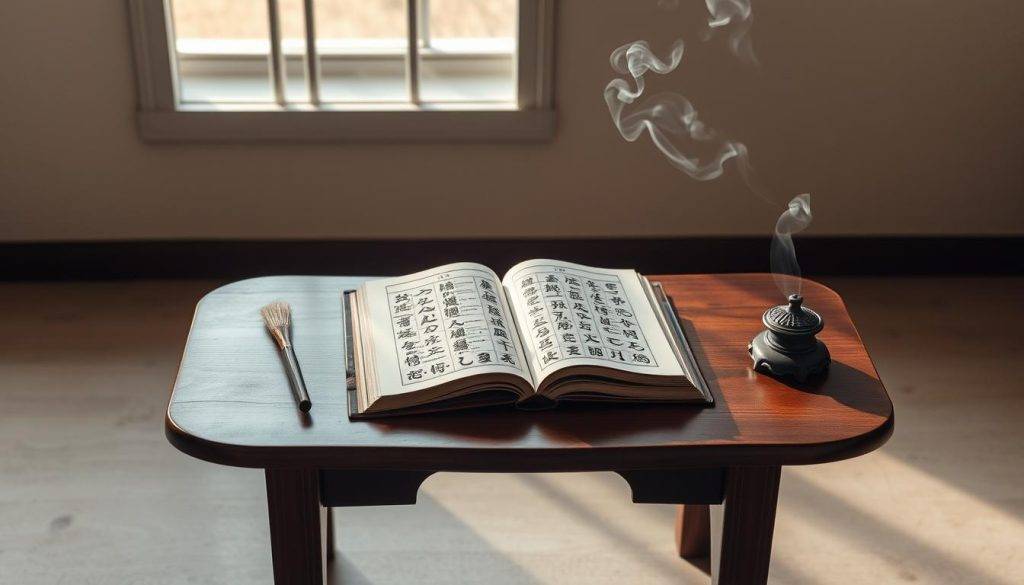
Morning Rituals for Focused Inquiry
A structured routine amplifies the message within each reading. Try this approach:
- Begin with deep breathing to calm mental chatter
- Formulate one focused question about current challenges
- Cast coins mindfully, observing how lines form
This process aligns intention with the philosophy’s timeless rhythms. Over weeks, these brief sessions build intuitive familiarity with hexagram symbols and their personal relevance.
Tracking Insights Through Journaling
Documenting readings reveals hidden connections. Note:
- Recurring hexagrams during specific emotional states
- Patterns in changing lines across similar questions
- Action steps taken and their outcomes
Review entries monthly to spot growth areas. Many discover their journal becomes a map of personal evolution – showing how early answers foreshadowed later breakthroughs.
Consistency matters more than duration. Set reminders or pair the practice with coffee rituals to reinforce the habit. Each session deepens trust in this philosophy, turning ancient symbols into modern answers for navigating uncertainty.
Aligning Your Choices with Taoist Philosophy
In the dance of existence, aligning decisions with Taoist principles fosters true balance. This ancient understanding teaches that harmony emerges when choices mirror nature’s rhythms rather than resisting them. Like water flowing around stones, Taoist philosophy emphasizes adaptability – making decisions that bend with life’s currents instead of forcing rigid outcomes.
The I Ching reveals how intentional actions shape the future through gradual alignment. Consider these contrasts in daily decision-making:
| Aligned Choice | Misaligned Choice |
|---|---|
| Responding to conflict with patience | Reacting impulsively to provocation |
| Adjusting career goals seasonally | Chasing promotions despite burnout |
| Nurturing relationships through listening | Dominating conversations to “win” |
Deep understanding of wu wei (effortless action) transforms challenges into growth opportunities. When facing crossroads, ask: “Does this choice honor my authentic nature?” The answer often lies in observing how trees grow – reaching upward while staying rooted.
By harmonizing with nature’s patterns, you cultivate a future shaped by wisdom rather than force. This approach turns obstacles into stepping stones, proving that alignment isn’t passive – it’s strategic cooperation with life’s unfolding design. Every intentional step becomes part of a larger dance toward fulfillment.
Exploring Key Hexagrams for Personal Development
Personal growth thrives when balanced between initiative and surrender. Two foundational hexagrams – 1 (The Creative) and 2 (The Receptive) – map this dance of progress. Their interplay teaches when to lead with boldness and when to trust life’s unfolding design.
Insights from Hexagram 1: The Creative
Hexagram 1 embodies yang energy – the spark igniting new ventures. Its six solid lines symbolize sustained action, urging decisive steps toward goals. A tech startup founder used this hexagram when launching an app, interpreting it as confirmation to invest fully despite risks.
Key lessons include:
- Prioritizing visionary leadership during growth phases
- Channeling ambition without forcing outcomes
- Recognizing when momentum requires acceleration
Understanding Hexagram 2: The Receptive
Hexagram 2’s six broken lines celebrate yin’s power. It advises nurturing existing things rather than chasing novelty. A teacher facing burnout applied its wisdom, shifting from overworking to collaborative delegation – aligning with natural rhythms.
| Aspect | Hexagram 1 | Hexagram 2 |
|---|---|---|
| Focus | Innovation | Consolidation |
| Symbol | Dragon ascending | Earth receiving rain |
| Action | Initiate | Integrate |
| Application | Career launches | Relationship healing |
Choosing your path involves discerning which energy dominates your current phase. A marketing director consulted both hexagrams when expanding her team – using Hexagram 1 to hire talent and Hexagram 2 to foster team cohesion.
These symbols don’t dictate answers but reveal frameworks for intentional living. By studying their patterns, you learn to dance between making waves and riding currents – mastering life’s eternal rhythm.
Case Studies and Real-Life Applications of I Ching Wisdom
Modern challenges demand solutions that bridge intuition and strategy. A tech executive grappling with burnout turned to hexagram 48 (“The Well”) for clarity. The reading emphasized replenishing inner resources before pursuing external goals. By balancing work energies with restorative practices, they redesigned their schedule – achieving 30% higher productivity within months.
Another example involves a teacher navigating pandemic-era classroom dynamics. Hexagram 59 (“Dispersion”) advised dissolving rigid structures to foster adaptability. She shifted to project-based learning, aligning her approach with students’ evolving needs. This transformation not only improved engagement but also reignited her passion for education.
Relationship conflicts often reveal imbalanced energies. One couple consulted hexagram 37 (“Family”) during marital strain. The text’s emphasis on mutual nourishment inspired weekly check-ins and shared decision-making. Their renewed communication framework became a cornerstone for rebuilding trust – proving ancient wisdom’s relevance in modern therapeutic contexts.
These stories demonstrate how the system’s symbolic language catalyzes transformation today. Whether managing career pivots or emotional hurdles, users gain frameworks to reframe obstacles as growth opportunities. The process doesn’t predict outcomes – it illuminates paths where intention and natural flow converge.
Key patterns emerge across cases:
- Readings often highlight overlooked perspectives
- Changing lines reveal pivotal decision points
- Balanced energy management precedes breakthroughs
By documenting these journeys, we see how 3,000-year-old principles continue guiding today’s seekers through life’s labyrinth – one hexagram at a time.
Advanced Tips for I Ching Interpretation
Delving deeper into hexagram analysis reveals hidden layers of meaning often missed in initial readings. Seasoned practitioners refine their approach by studying how changing lines interact with broader patterns, creating a dynamic dialogue between symbols and lived experience.
Identifying Changing Lines and Their Impact
Not all moving lines hold equal weight. Prioritize lines in positions 2 and 5 – the “ruler” placements influencing entire hexagrams. A changing line here might indicate:
- Core relationship dynamics needing adjustment
- Career opportunities requiring immediate action
- Internal conflicts affecting decision clarity
The yarrow stalk method enhances sensitivity to these shifts. Its slower ritual amplifies intuition, helping distinguish urgent transformations from background noise. Unlike coin tosses, stalk divisions create mathematical nuances revealing how energies evolve across times.
Exploring Patterns for Deeper Insights
Track hexagram sequences over multiple sessions. If Hexagram 44 (“Coming to Meet”) appears frequently during partnership challenges, it signals recurring attraction to incompatible alliances. Advanced ways to decode patterns include:
| Pattern Type | Interpretation Strategy |
|---|---|
| Mirror Hexagrams | Compare opposing symbols (e.g., 1 & 2) for balance checks |
| Seasonal Clusters | Note readings during solstices or equinoxes |
| Line Position Trends | Identify stuck energies in specific positions |
Refining the yarrow stalk method by counting stalk remainders (24 vs. 28) adds precision. These subtleties help detect whether challenges stem from external events or internal resistance – a distinction crucial for effective problem-solving.
Conclusion
Navigating life’s complexities becomes clearer when ancient wisdom meets modern intention. The system’s 64 hexagrams—especially their evolving changing lines—offer more than answers. They reveal patterns in challenges, relationships, and crossroads, transforming uncertainty into strategic clarity.
Each consultation invites a book change—a shift in perspective that aligns choices with natural rhythms. By studying how changing lines transform, users uncover hidden opportunities in career moves or personal dilemmas. This dynamic framework turns static advice into living guidance, adaptable to life’s constant flux.
True personal growth emerges through consistent practice. Like seasons, insights deepen over time, revealing when to act boldly or pause thoughtfully. The journey isn’t about perfection but progress—a continuous dialogue between intention and outcome.
Embrace this timeless tool as a compass, not a crutch. Let its symbols illuminate paths where logic meets intuition, and where every challenge becomes a stepping stone toward wisdom. The next chapter of understanding awaits—cast the coins, read the lines, and begin.




























































